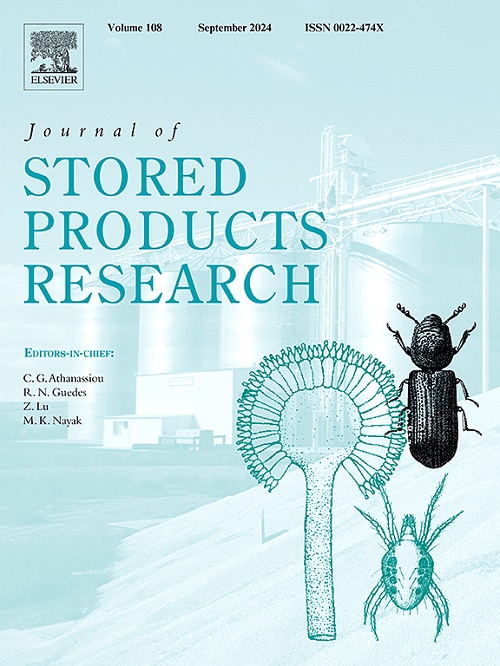Unraveling grain vulnerability to the khapra beetle (Trogoderma granarium): Structure and mineral content
IF 2.7
2区 农林科学
Q1 ENTOMOLOGY
引用次数: 0
Abstract
The pest-substrate relationship plays a crucial role in infestation dynamics, yet certain economically significant invasive pests, such as the khapra beetle (Trogoderma granarium), remain understudied. This study examines the susceptibility of different grain species and substrates to T. granarium infestation, focusing on the influence of grain physical properties and mineral composition. Laboratory trials assessing whole and processed grains revealed that structural integrity significantly affects pest colonization. Hard grains, such as rice, exhibited lower infestation rates, whereas softer grains, like wheat and maize, provided more favorable conditions for larval development. Processed forms, including cracked grains and flour, showed heightened vulnerability, likely due to increased surface area facilitating pest feeding and reproduction. Additionally, mineral composition emerged as a potential determinant of susceptibility, with higher magnesium content correlating with increased pest performance, suggesting a role for mineral availability in pest development. These findings highlight the multifactorial nature of grain susceptibility, where both physical barriers and chemical properties shape infestation dynamics. The study underscores the need for integrated pest management strategies that consider grain type, processing state, and nutritional composition. Future research should explore the biochemical mechanisms underlying insect-mineral interactions and assess potential breeding or storage interventions to mitigate pest impact. A deeper understanding of these complex relationships is critical for developing targeted strategies to preserve grain quality and reduce post-harvest losses, ensuring food security in global storage systems.
揭示粮食对卡巴拉甲虫(Trogoderma granarium)的脆弱性:结构和矿物质含量
害虫与基质的关系在虫害动态中起着至关重要的作用,但对某些具有重要经济意义的入侵害虫,如卡普拉甲虫(Trogoderma granarium)的研究仍然不足。本研究探讨了不同谷物种类和基质对 T. granarium 侵染的敏感性,重点关注谷物物理特性和矿物质成分的影响。对整粒谷物和加工谷物进行评估的实验室试验表明,谷物结构的完整性对害虫的定殖有显著影响。大米等硬谷物的虫害率较低,而小麦和玉米等软谷物则为幼虫发育提供了更有利的条件。经过加工的谷物(包括碎谷物和面粉)更容易受到虫害,这可能是由于表面积增大,有利于害虫取食和繁殖。此外,矿物质成分也是易感性的潜在决定因素,镁含量越高,害虫的表现越明显,这表明矿物质的可用性在害虫的发展过程中起着一定的作用。这些发现凸显了谷物易感性的多因素性质,即物理障碍和化学特性都会影响虫害动态。这项研究强调了综合虫害管理策略的必要性,该策略应考虑谷物类型、加工状态和营养成分。未来的研究应探索昆虫与矿物质相互作用的生化机制,并评估潜在的育种或储藏干预措施,以减轻害虫的影响。更深入地了解这些复杂的关系对于制定有针对性的策略以保护谷物质量和减少收获后损失,确保全球储藏系统的粮食安全至关重要。
本文章由计算机程序翻译,如有差异,请以英文原文为准。
求助全文
约1分钟内获得全文
求助全文
来源期刊
CiteScore
5.70
自引率
18.50%
发文量
112
审稿时长
45 days
期刊介绍:
The Journal of Stored Products Research provides an international medium for the publication of both reviews and original results from laboratory and field studies on the preservation and safety of stored products, notably food stocks, covering storage-related problems from the producer through the supply chain to the consumer. Stored products are characterised by having relatively low moisture content and include raw and semi-processed foods, animal feedstuffs, and a range of other durable items, including materials such as clothing or museum artefacts.

 求助内容:
求助内容: 应助结果提醒方式:
应助结果提醒方式:


